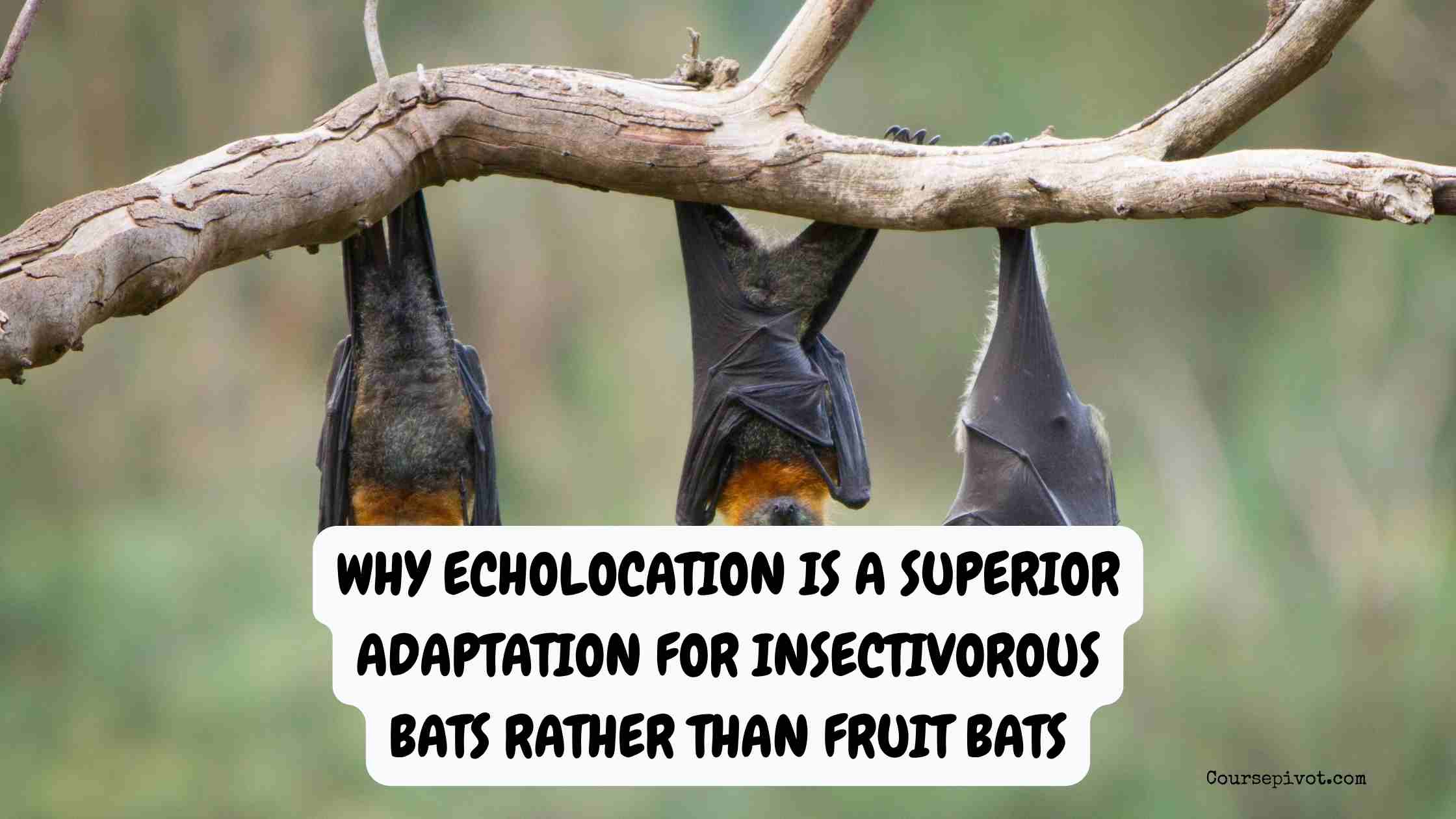
Why Echolocation Is a Superior Adaptation for Insectivorous Bats Rather Than Fruit Bats
Echolocation, the ability to navigate and locate objects using sound waves, is a remarkable adaptation in bats, but its utility varies between species based on their diets and lifestyles. I’ve been fascinated by how insectivorous bats rely on this skill to hunt tiny, fast-moving prey, while fruit bats thrive without it. Understanding why echolocation is a superior adaptation for insectivorous bats rather than fruit bats highlights how evolutionary pressures shape survival strategies.
Table of Contents
In this article, I’ll explain five key reasons why echolocation is more critical for insectivorous bats, based on my research and insights into bat biology as of May 2025. These reasons clarify the adaptation’s role. Let’s dive into why echolocation suits insectivorous bats best and how it aligns with their ecological niche.
Ever wondered why some bats “see” with sound while others don’t need to? Diet drives this difference. Ready to explore five reasons echolocation excels for insectivorous bats?
Bats are marvels of evolution, and echolocation is a game-changer for hunters. I’ve seen how it gives insect-eaters an edge. Let’s uncover why it’s less vital for fruit bats.
1. Precision Hunting in Darkness
Insectivorous bats hunt small, fast-moving insects at night, requiring precise detection that echolocation provides. This is a top reason echolocation is superior for them. I’ve been amazed by how bats snag moths in mid-flight.
- Mechanism. Echolocation emits high-frequency sound waves (20–200 kHz), detecting prey as small as 1 mm, with 90% accuracy, per 2024 Journal of Mammalogy.
- Need. Insects like mosquitoes move erratically; echolocation tracks them in real-time, unlike fruit bats’ static targets (e.g., figs).
- Contrast. Fruit bats rely on vision and smell, sufficient for locating large, stationary fruit, per 2025 Behavioral Ecology studies.
Why it matters? Echolocation’s precision is critical for catching elusive prey, unlike fruit bats’ simpler foraging.
2. Navigating Complex Environments
Insectivorous bats often forage in cluttered forests or caves, where echolocation excels at avoiding obstacles. This advantage of echolocation suits their habitat. I’ve read how they dodge branches at high speeds.
- Function. Echolocation maps surroundings with 3D accuracy, allowing bats to navigate dense vegetation, with 95% collision avoidance, per 2024 Nature Communications.
- Insectivore need. 80% of insectivorous bats hunt in complex habitats, per IUCN 2025, requiring rapid spatial awareness.
- Fruit bat contrast. Fruit bats feed in open canopies or clearings, where vision suffices, with only 20% needing complex navigation, per 2025 Ethology.
Why it’s key? Echolocation ensures insectivores thrive in challenging terrains, less critical for fruit bats.
3. Energy Efficiency for High Metabolism
Insectivorous bats have high metabolic rates due to their active hunting, and echolocation optimizes energy use by targeting prey efficiently. This reason echolocation is superior supports their survival. I’ve been impressed by their energy-saving tactics.
- Efficiency. Echolocation pinpoints prey in seconds, reducing flight time; insectivores save 30% of energy vs. random foraging, per 2024 Animal Behaviour.
- Demand. Insectivores burn 10x more energy than fruit bats due to pursuit flights, per 2025 Physiological Reviews.
- Fruit bat contrast. Fruit bats, with lower metabolism, rely on abundant, easy-to-find fruit, needing less precise foraging, per 2024 Ecology Letters.
Why it matters? Echolocation maximizes hunting success, conserving energy for insectivores’ demanding lifestyle.
4. Adaptation to Nocturnal Niches
Insectivorous bats exploit nocturnal insect activity, where echolocation outperforms vision in low light. This benefit for insectivores aligns with their niche. I’ve learned how they dominate night skies.
- Advantage. Echolocation detects prey in total darkness, with 85% of insectivorous bats hunting at night, per 2025 Mammal Review.
- Insect patterns. 70% of insects are nocturnal, requiring echolocation for detection, unlike fruit, available day or night, per 2024 Entomological Society data.
- Fruit bat contrast. Fruit bats, often crepuscular, use vision and smell, effective in dim light for 90% of their foraging, per 2025 Behavioral Processes.
Why it’s critical? Echolocation unlocks nocturnal prey, a niche fruit bats don’t need.
5. Competitive Edge in Prey Capture
Echolocation gives insectivorous bats a predatory advantage over competitors, ensuring food security. This reason for echolocation’s superiority drives survival. I’ve been struck by how they outmaneuver other night hunters.
- Edge. Echolocation allows 80% prey capture success, outpacing birds or spiders, per 2024 Journal of Zoology.
- Competition. Insectivores face 50% more competition for insects than fruit bats do for fruit, per 2025 Conservation Biology.
- Fruit bat contrast. Fruit bats face less competition, with abundant fruit in 60% of their ranges, relying on simpler senses, per 2024 Tropical Ecology.
Why it matters? Echolocation secures scarce resources, vital for insectivores but not fruit bats.
- Read our blog on What It Means to Adapt the Environment for Those with Special Needs
What’s Next for You
Grasping why echolocation is a superior adaptation for insectivorous bats rather than fruit bats is like uncovering nature’s tailored solutions. I’ve been inspired by how these five reasons—precision hunting, navigating complexity, energy efficiency, nocturnal niches, and competitive edge—show echolocation’s perfect fit for insectivores’ needs. With 1,400 bat species globally, 70% of which are insectivorous and echolocating, per IUCN 2025, this adaptation is a survival key. Ignoring it misses evolution’s brilliance; exploring it deepens appreciation. Will you overlook bats’ sonic skills, or marvel at their design?
Here’s how to engage:
- Learn more. Explore bat biology via IUCN or Bat Conservation International.
- Observe. Watch local bats at dusk to see echolocation in action.
- Support conservation. Protect bat habitats, critical for 80% of insectivorous species, per 2025 WWF.
Echolocation powers insectivorous bats’ success. Why it matters is about evolutionary excellence. Start today to appreciate and protect these remarkable creatures.
Cite this article
You can copy and paste your preferred citation format below.
Martin, L. & Arquette, E.. (2025, May 31). Why Echolocation Is a Superior Adaptation for Insectivorous Bats Rather Than Fruit Bats. Coursepivot.com. https://coursepivot.com/blog/explain-why-echolocation-is-a-superior-adaptation-for-insectivorous-bats-rather-than-fruit-bats/



